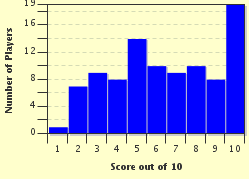Quiz Answer Key and Fun Facts
1. In the first decade of the fourteenth century, King Edward I was nearing the end of his life, and reign. He was still engaged in fighting. Which man was executed on his orders in 1305 by the method of hanging, drawing and quartering?
2. Although work originally began in the late eleventh century, in 1311 work on the spire of a cathedral raised it to a height which gave it the record of the world's tallest building. In which city, located in the East Midlands of England, was this cathedral?
3. King Edward II was on the English throne, but his reign effectively ended in 1326 following an invasion of the country led by Roger Mortimer, and Edward's own wife, who was originally a French princess. What was her name?
4. The beginning of the Hundred Years' War dates from 1337, when Edward III refused to acknowledge Philip VI of France as his monarch, leading the latter to confiscate which duchy which Edward had inherited?
5. 1348 saw the first outbreaks of what became known as the 'Black Death'. Which south western port was the first large town to suffer its ravages?
6. This man was born in Gloucestershire and is recorded as travelling to London in 1358, where he made his fortune as a mercer. He became Lord Mayor in 1397, a position he held on four occasions. Who was he?
7. Although the dates given for the text of 'Piers Plowman' vary, the British Library states the earliest version dates from 1367. The authorship is credited to which of these men?
8. 1376 saw the death of the eldest son of Edward III, also called Edward and known as the Black Prince. In which Oxfordshire palace was he born?
9. 1381 saw an uprising of the common people against the monarchy and government. Sometimes called 'Wat Tyler's Rebellion' or the 'Great Rising', its more usual name is which of these?
10. The final year of the century, 1399, saw the death of John of Gaunt, the third son of Edward III. He was the duke of which city?
Source: Author
rossian
This quiz was reviewed by FunTrivia editor
bloomsby before going online.
Any errors found in FunTrivia content are routinely corrected through our feedback system.

